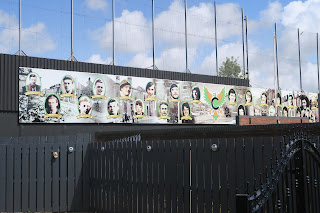In recent years there has been a move to replace the more aggressive and militaristic images with murals dedicated to local heroes and famous figures however, many of the original murals still remain.
The first Republican murals appeared in 1981, when the hunger strike by Republican prisoners saw the emergence of dozens of murals of support. Also prominent is the image of Bobby Sands, who was one of the ten prisoners who starved themselves to death - Bobby was elected as a local MP shortly before his death. A phoenix rising from flames (symbolizing Ireland reborn from the flames of the 1916 Easter Rising) is commonly seen in Republican murals, as well they often show support for other rationalist and republican movements around the world, including Palestine and recently Catalonia.
Loyalist murals have traditionally been more militaristic and defiant in tone. Paramilitary insignia and images of King Billy are common, as are references to the WW1 Battle of the Somme in 1916 in which many Ulster soldiers died: it is seen as a symbol of Ulster’s loyalty to the British crown, in contracts to the Republican Easter Rising of 1916.
Can you see where I signed the ‘peace wall’?
The gates on both sides of the street are open right now...but they will close later in the day
The longest section divides the Falls Road and the Shankill in West Belfast...and even today its steel gates are generally open during daytime hours, but closed at night!
Taxi tours are the best way to see the murals and the ‘peace wall’ - in general they’re an intimate and entertaining way to see the sights, with the taxi driver being a local person, often someone who lived through the Troubles.























No comments:
Post a Comment